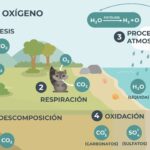We explain what sublimation is as a physical-chemical process, psychoanalytic concept and artistic or design technique.

What is sublimation?
Sublimation is a process that occurs when a substance in a solid state changes to a gaseous state (without the need to go through the liquid phase). The word “sublimation” comes from the Latin verb I will sublimate which means “to rise”, “to place oneself in a high position” or “to soar upward”.
Furthermore, “sublimation” is a term used in psychoanalysis to refer to a very important process of psychic life; and in photography and graphic art to refer to a high-quality printing technique.
See also: Physical change
Sublimation as a physical-chemical process
Sublimation is the direct passage of a solid substance to the gaseous state without first passing through the liquid phase. The reverse process is known as “reverse or regressive sublimation.” and consists of solidifying that gas obtained again, without going through the liquid state.
Often, Both processes are used for the distillation or purification of certain solid substances. To do this, a sublimator is used: a special container that heats the solid substance until it passes into the gas phase.
The sublimator has a very cold piece, known as a “cold finger condenser,” because of its finger-like shape. The previously obtained gas passes through this section of the sublimator to solidify again and deposit on the surface.
Examples of physical-chemical sublimation

- Dry ice is carbon dioxide solid. At a temperature of -78ºC and ambient pressure (1 atm) it sublimes and becomes carbon dioxide vapor.
- In metallurgy, sublimation processes are used to purify certain alloys, as occurs, for example, in obtaining metallic zinc.
- At a suitable temperature, the arsenic It sublimes from solid to gas.
- He iodine subjected to a temperature of approximately 100 ºC, transforms into a toxic purple gas that is used in police work to capture fingerprints.
- In astronomy the phenomenon of sublimation is observed when the kites They pass near the sun.
- The naphthalene Sublimates easily at room temperature and pressure.
- About fields of snow when there is a strong sun but the temperature is very low, it is possible to see how the ice vaporizes without going through the liquid phase. These natural phenomena of water sublimation can be observed in North America, the Russian Taiga, the Alpine region, the Himalayan mountains and South America.
Sublimation in psychoanalysis
Freud developed the psychoanalytic concept of “sublimation” to describe a defense mechanism through which certain impulses that do not coincide with what we consider acceptable are redirected. For example, a violent impulse can be sublimated through works of art that depict violence.
Freudian “sublimation” is the way of channel or channel self-destructive impulses into productive behaviors or creators. This reduces the anguish that these impulses cause.
Drives unacceptable to the ego would obtain their energy from the sexual drive even though, apparently, they have no relation to sexuality. It is important to emphasize this since “sublimation” has nothing to do with the repression of the sexual.
“Sublimation” channels these energies, giving them a socially noble, productive, artistic or scientific purpose, while repression simply denies and frustrates those impulses.
Sublimation in photography and graphic arts

Sublimation in graphic arts is a digital printing technique which has made it possible to print high quality of all kinds of images, photographs and designs on materials such as metal, aluminum, plastic or wood.
Sublimation printers convert the ink in their ribbons into gas and, through heat, inject that gas at high temperature into the material where you want to fix the image.
Continue with: Condensation
References
- “Sublimation” on Wikipedia.
- What is sublimation? in BRILLOR.
- “Sublimation, Phase Change” in Encyclopaedia Britannica.
- “What is Sublimation in Chemistry? – Definition, Process & Examples” on Study.com.
- “Sublimation (psychoanalysis)” on Wikipedia.





